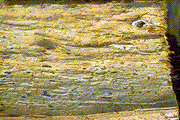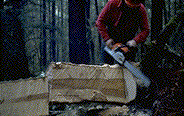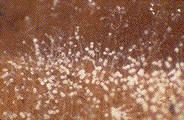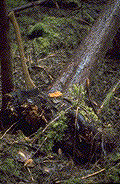Archived Content
Information identified as archived on the Web is for reference, research or recordkeeping purposes. It has not been altered or updated after the date of archiving. Web pages that are archived on the Web are not subject to the Government of Canada Web Standards. As per the Communications Policy of the Government of Canada, you can request alternate formats on the Contact Us page.
Annosus Root and Butt Rot
(At https://advanced-writer.com/ you're free to see the examples of similar reports or even order a new one.)
Heterobasidion annosum (Fr.:Fr.) Bref.
(= Fomes annosus (Fr.:Fr.) Cooke)
(anamorph = Spiniger meineckellum (A. Olson) Stalpers)
Basidiomycotina, Aphyllophorales, Polyporaceae
Hosts:Heterobasidion annosum has a very wide host range including both coniferous and broadleaved species. It has been reported in B.C. on amabilis and grand fir, white and Sitka spruce, lodgepole pine, Douglas-fir, western redcedar, western hemlock, bigleaf maple, and alder. In other parts of North America it has also been found on mountain hemlock, California incense cedar, juniper, subalpine fir, western larch, ponderosa and western white pine, Engelmann spruce, chestnut, hickory, honeysuckle, apple, poplar, oak,, sagebrush, Arbutus, Arctostaphylos, Camellia, Cercocarpus Chamaecyparis thyoides, Diospyros, Kalmia, Pachistima, Prunus spp., antelope-brush, Rhododendron, Sequoia, and Sequoiadendron. Two forms of the fungus are recognized in North America: the p-type, which occurs mainly on pine, incense cedar, hardwood and brush, and the s-type, which infects other conifer species. The p-type will infect both p-and s-type hosts, whereas the s-type is restricted to s-type hosts. To date only the s-type has been detected in B.C.
Distribution: This fungus affects trees west of the coast mountains and in the Interior Cedar Hemlock biogeoclimatic zone.
Identification: Fruiting bodies are perennial, woody to leathery, and vary in form from effused-reflexed or resupinate to bracket-like (Figs. 2a, 2b). The upper surface is zoned, dark brown to black, and has an acute margin. The lower surface is white to cream, and poroid; the pores are small and irregular in outline. The context is white to cream. Fruiting bodies are most often found on the underside of decayed roots of living and standing-dead trees. On standing trees, it may be necessary to remove the duff from around the root collar to locate them. Fruiting bodies may also be found on the underside of stems and/or roots of windthrown trees.
The incipient stage of H. annosum decay is a yellow-brown to red-brown stain (Fig. 2c), while in advanced stages the wood is reduced to a white stringy or spongy mass (Fig. 2d) containing numerous small black flecks running parallel to the grain. In the final stage, the wood is completely degraded, leaving a hollow butt. Decay may extend as high as 10-15 m in the stem (Fig. 2e). Small (2-4 mm diameter), cream-coloured mycelial pustules are frequently present on the surface of roots decayed by H. annosum. A useful diagnostic procedure to identify decay of H. annosum is to wrap an infected wood sample in moist paper, enclose it in a plastic bag, and store it at room temperature. Within 5-6 days, asexual fruiting structures (conidiophores) will form on the wood surface (Fig. 2f). When viewed with a hand-lens or dissecting microscope these have a characteristic hemispherical shape.
Microscopic Characteristics: Contextual generative hyphae thin-walled, simple septate. Growth in culture rapid, mat white with patches of yellow and buff, simple septae or rare clamp connections, conidiophores with globose heads, laccase positive. Stalpers: 1 (2) 3 (6) (7) (8) (9) (11) (12) (13) (14) (15) 18 (19) 21 (22) (24) 25 (26) 30 31 (35) (38) (39) (40) 45 (48) (50) (51) 52 53 54 (55) (57) (64) (67) (80) (82) 83 86 87 (89) (90).
Damage: Trees younger than 15 years that have a major portion of their root system killed by H. annosum exhibit crown symptoms typical of other root diseases (i.e., reduction in leader and branch growth, chlorotic foliage, and a distress cone crop). In more mature trees, however, the fungus causes a butt rot and external symptoms are not readily discernible. Trees with extensive decay in the structural roots are subject to windthrow (Fig. 2g), and groups of windthrown trees may indicate the presence of pockets of annosus root rot.
Remarks: Spores are present in the atmosphere on the coast throughout the year and can be carried by air currents for many miles. Infection by spores occurs through wounds on stems or roots, or through cut surfaces of fresh stumps. The fungus moves to surrounding trees through root grafts or root contact. Stand thinning treatments or damage to trees from logging operations can therefore intensify annosus root rot problems. Heterobasidion annosum is able to survive in stumps for several decades. The treatment of stump surfaces with borax has been used to prevent spore infection. Other control recommendations include shortened rotations and avoidance of wounding during logging. Immature fruiting bodies of this fungus could be confused with Fomitopsis pinicola but can generally be distinguished by the location on the tree. In addition, F. pinicola has very regular pores (pin-hole like) whereas the pores of H. annosum are irregular in shape.
References:
Morrison, D. J. and A. L. S. Johnson. 1978. Stump colonization and spread of Fomes annosus 5 years after thinning. Can. J. For. Res. 8:177-180.
Otrosina, W. J. and R. F. Scharpf (tech. coord.). 1989. Proc. Symp. on research and management of annosus root disease (Heterobasidion annosum) in western North America. USDA For. Serv., Gen. Tech. Rep. PSW 116.
Figures
Click on any image to see the full size version.
Press "Back" on your browser to return to this screen.

Figure 2a: Mature H. annosum fruiting bodies.
 Figure 2b: Mature H. annosum fruiting bodies.
Figure 2b: Mature H. annosum fruiting bodies.
 Figure 2c: Incipient decay of H. annosum in western hemlock stump.
Figure 2c: Incipient decay of H. annosum in western hemlock stump.
 Figure 2d: White stringy decayed wood showing black flecks parallel to grain.
Figure 2d: White stringy decayed wood showing black flecks parallel to grain.
 Figure 2e: Incipient butt rot in red alder stem.
Figure 2e: Incipient butt rot in red alder stem.
 Figures 2f: Conidia of H. annosum.
Figures 2f: Conidia of H. annosum.
 Figure 2g: Windthrown western hemlock with annosus root rot.
Figure 2g: Windthrown western hemlock with annosus root rot.
 This Web page has been archived on the Web.
This Web page has been archived on the Web.